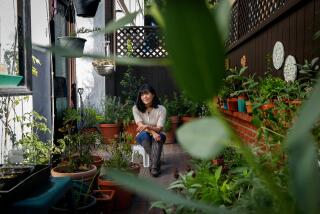Umbrella Loves to Open Indoors : GARDENING
To those who claim a non-green thumb, there is a houseplant that virtually anyone can grow.
The most common problems with houseplants arise from improper watering.
Some plants suffer slow death in soil that is constantly waterlogged; others slowly expire in soil allowed to go bone dry between waterings. And some plants are forced to alternate between these extremes.
The plant I have in mind is called umbrella plant ( Cyperus alternifolius ) and requires no skill in watering.
Because the umbrella plant is native to shallow waters, you never have to decide whether to water. Water is always needed.
Grow this plant by standing its pot in a deep saucer that you always keep filled with a couple of inches of water. What could be simpler? One caution, though. The top edge of the saucer does have to be below the rim of the pot. Umbrella plants like their roots constantly bathed in water, but not their stems.
The umbrella plant is not a homely plant, sacrificing good looks for ease of care.
The plant is a graceful clump of bare, slender stems, each stem capped by a whorl of leaves radiating out like the ribs of a naked umbrella. The stems are two to four feet tall and each leaf four to eight inches long.
A dwarf form of the plant, botanically C. albostriatus, grows only a foot or so high and has grassy leaves growing in among the stems at its base. There is also a white-speckled form of umbrella plant and a wispy one with especially thin leaves and stems.
Umbrella plants are not finicky about care other than watering. They grow best in sunny windows but will get along in any bright room.
As far as potting soil, your regular homemade or packaged mix will suffice. Umbrella plants like a near-neutral pH, as do most other houseplants.
The plants do require periodic repotting as they begin to crowd their pots. Shift the large plant into a yet larger pot, or make new plants by dividing the large clump into smaller clumps and potting each of them separately.
One way umbrella plants reproduce in the wild is by taking root where their stems arch over to touch the ground. You can mimic this technique indoors.
Fold the leaves down around the stem with a rubber band, as if you were closing the umbrella. Cut the stem a few inches below the whorl of leaves and poke the umbrella, leaves pointing upward, into some potting soil--kept constantly moist, of course.
Although you may be unfamiliar with the umbrella plant, you probably have come across its near-relatives either in the garden or in literature.
One relative is yellow nutsedge ( C. esculentum ), a plant usually considered a weed and inhabiting wet soils all the way from Maine down to the tropics.
But esculentum in Latin means âsucculentâ and refers to the sweet, nutlike tubers this plant produces below ground.
Umbrella plantâs other well-known relative is papyrus ( C. papyrus ), a plant that once grew wild along the Nile. In ancient times, papyrus was used not only to make paper but also to build boats and as food.
Papyrus looks much like the umbrella plant and, being subtropical, also would make a good houseplant.
But with stems that can soar 15 feet high, this species is too tall for most living rooms.






